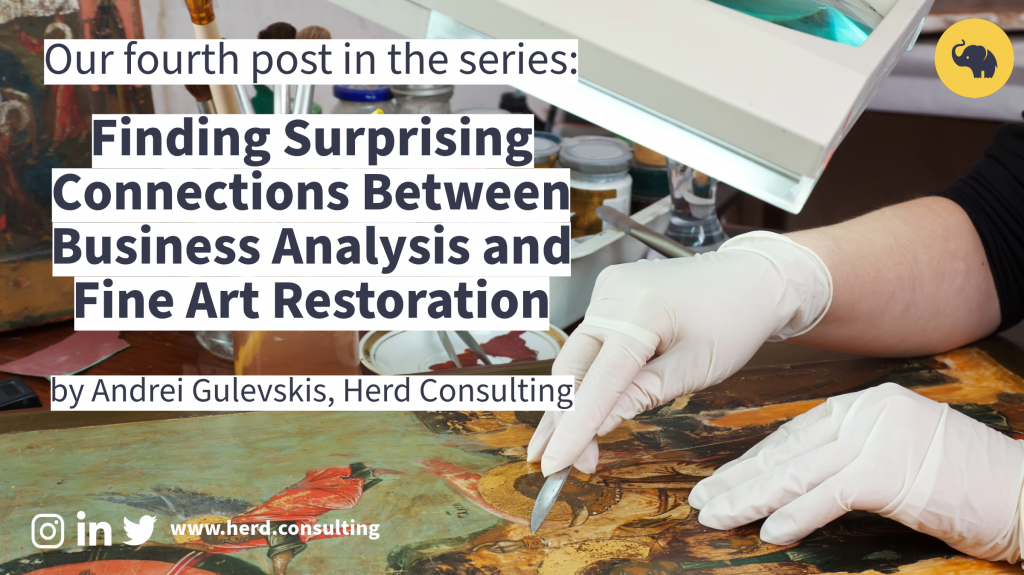
This is our fourth blog post in our hobbies x business analysis series. Well done to fellow Herder, Andrei Gulevskis. If you’d like to join our growing list of guest bloggers then please get in touch.
Recently, I’ve been hooked on a particular YouTube channel – Baumgartner Restoration that demonstrates the process of fine art conservation and restoration. Apart from just being very aesthetically pleasing and satisfying to see a painting being brought back to life by the conservator Julian, you just can’t resist to be captivated by his mastery of skills and passion he demonstrated for the craft.
There’s something about Julian’s approach that got me thinking about how it parallels to what we do in business analysis. I know it’s a bit of an odd comparison, considering the different worlds we operate in, but bear with me. Often, we can learn and improve our own skills by observing professionals from completely different industries and going outside of our usual bubble.
Understand what client wants and what the project needs
Julian starts with understand the requirements and goals of the restoration project – what does the client want to be done to the painting and what is the overall goal of the restoration. Sometimes the client wants a complete and meticulous restoration, sometimes just a light touch-up. Sometimes the end goal is to have a painting be displayed in a gallery or stored for investment purposes, and sometimes to hang in their home to simply enjoy it. But, as is usually the case, what the client wants and what the paining actually needs might differ.
Digging deeper
Julian performs an analysis of the painting by utilising various observation techniques, looking at the painting under UV light and performing chemical analysis. Based on the findings, he would consult with the client and discusses the course of action for the restoration – what can actually be done, what must be done in order to preserve the structural integrity of the paining, and what can be done to satisfy the client wishes and requirements.
Sometimes the project is straightforward – clean the painting and retouch the paint, and that is all that is needed. But sometimes a more creative approach is needed where a paining has been badly damaged, or the materials used in the painting are unconventional.
Uncovering the layers
Once the plan and overall goals of the restoration have been set, the work can begin. Julian would start by removing the painting out of the frame, cleaning it from dirt, old varnish, glue. And as he is “peeling off the layers”, he is uncovering more information about the paining. And sometimes it would present a bigger challenge than initially expected. It can be bad work done by previous conservators who used too aggressive approach, it can be poor structural integrity, mould that needs to be treated, or excessive damage that has not been visible under the layers of dirt and overpaint. And the conservator would adjust their plan and approach, consulting with the client, making sure that things like budget and time are taken into consideration.

Learning from others
Through years of developing his skills, Julian knows what needs to be done even most delicate situations. But then there would be occasions where a paining would present a brand-new challenge where existing knowledge and skills are not enough. And the conservator would consult with professionals from other industries – woodworking, engineering, sculpture, to learn and understand how to solve a particular problem.
Future Considerations
Just as the painting survived for hundreds of years, it can be preserved for hundreds of years to come. Julian is not the first one to conduct restoration on the painting, and he is not the last. So, one of the objectives is to ensure that future restoration can be done as easily and stress-free as possible. This is ensured by the materials, tools, and techniques that Julian uses. A full report is produced that shows what was done to the painting in detail. This report is vital for the client to have and future conservators to see.
Taking pride in job well done
And once the restoration is complete, the conservator presents us with a beautiful painting, put back together, with new life given to it, and that can be enjoyed for generations to come. All the time, effort and skills put into the work results in something that millions of people can enjoy.
Parallels with Business Analysis
By this point any keen Business Analyst will have noticed the parallels that I was hinting on, as you can clearly see similarities in the approach between the two.
By doing discovery work and talking with your stakeholders you understand their requirements for the project. But do not forget to investigate the overall context for the project. Remember that what the stakeholders want and what is needed, can be different.
- Have a good plan of approach and talk it though with your stakeholders.
- Stay flexible and agile. Projects can throw an unexpected challenge that you were not prepared for once you are already in the thick of it.
- If you feel a bit out of your element, do not be afraid to consult with colleagues and other professionals. There is much that we can learn from others.
- Think about others who might rely on your work in the future. Have you made sure to create clear and sufficient documentation? Do stakeholders understand what you have done, and would they be able to continue work, if needed, even if you are not around?
- Make sure to take pride in your work and always do it to the best of your abilities.
In conclusion, while the realms of business analysis and fine art restoration may seem worlds apart, the shared principles of understanding, analysis, adaptability, collaboration, and craftsmanship highlight the unexpected but undeniable parallels between the two. By embracing these similarities, we can enrich our own professional practices and find inspiration in the unlikeliest of places.
If anyone fancies a brew and a natter about their hobbies and interests, or to even chat through our range of business analysis & product management services, drop us a message. We’ve got posh coffee (Darkwoods) and Chocolate Hobnobs.
🖊️ Authored by: Andrei Gulevskis, Senior Business Analyst, Herd Consulting
🎧 Most listened to album of 2023: ‘”Take Me Back to Eden” by Sleep Token
For all the latest updates